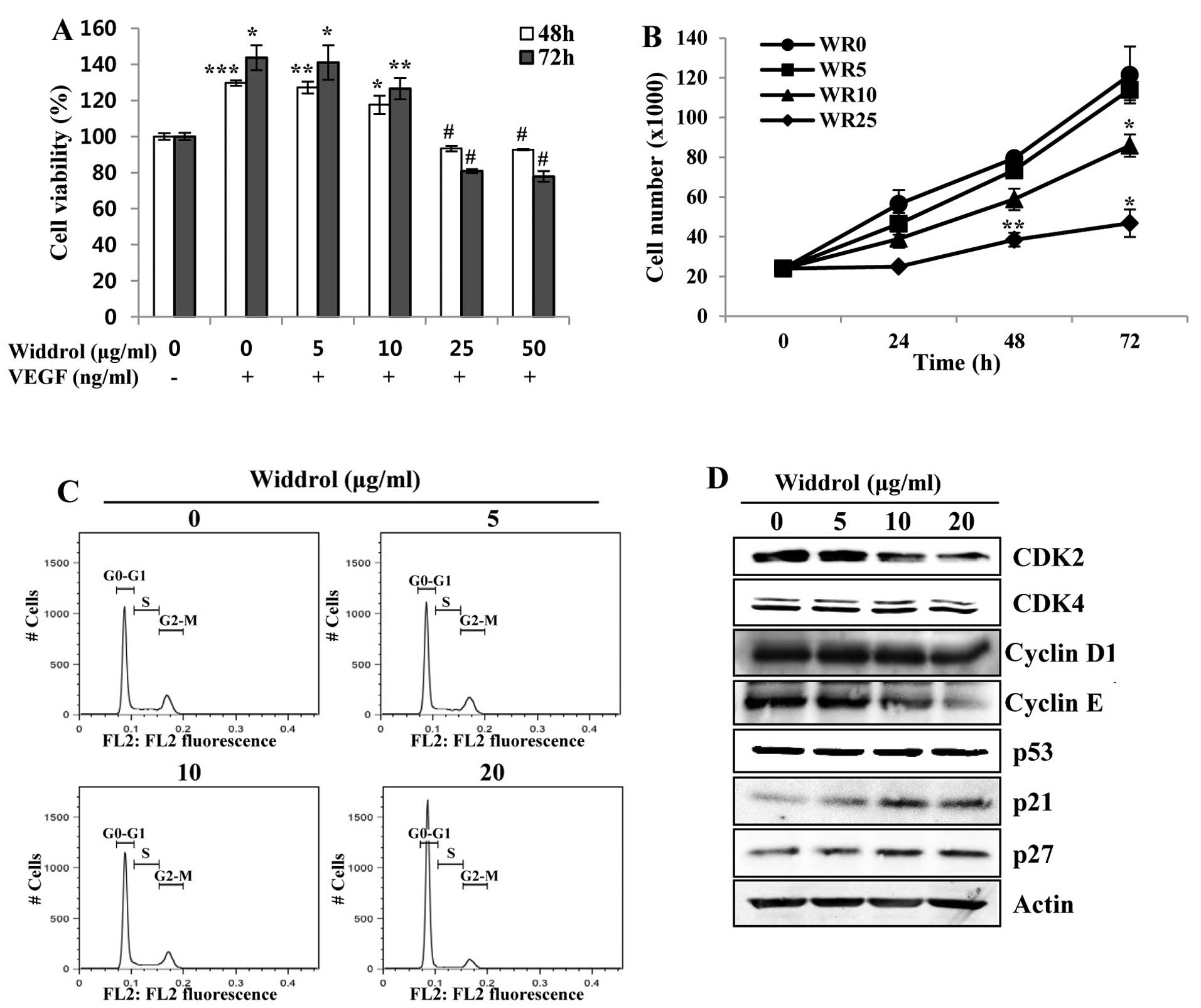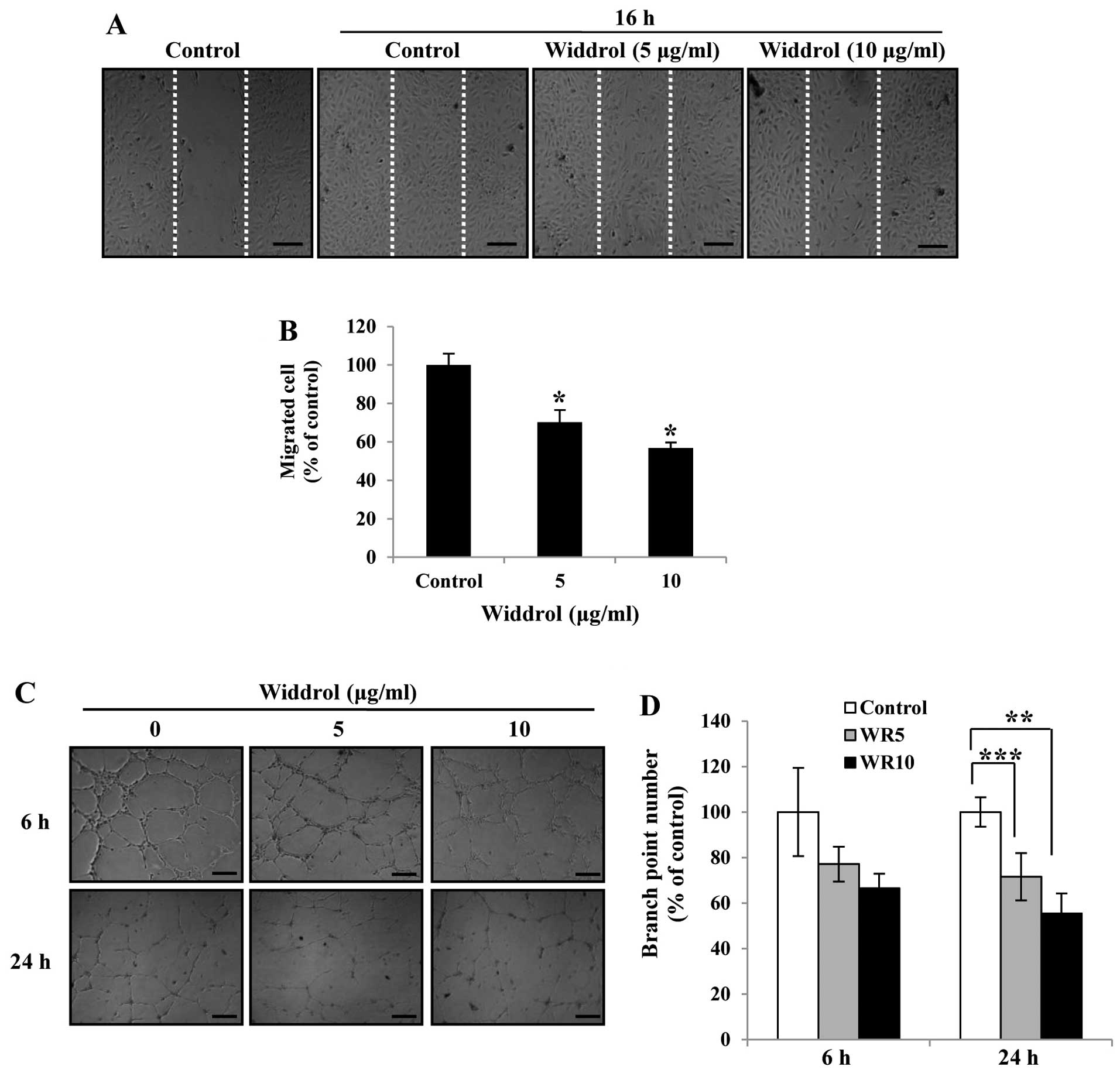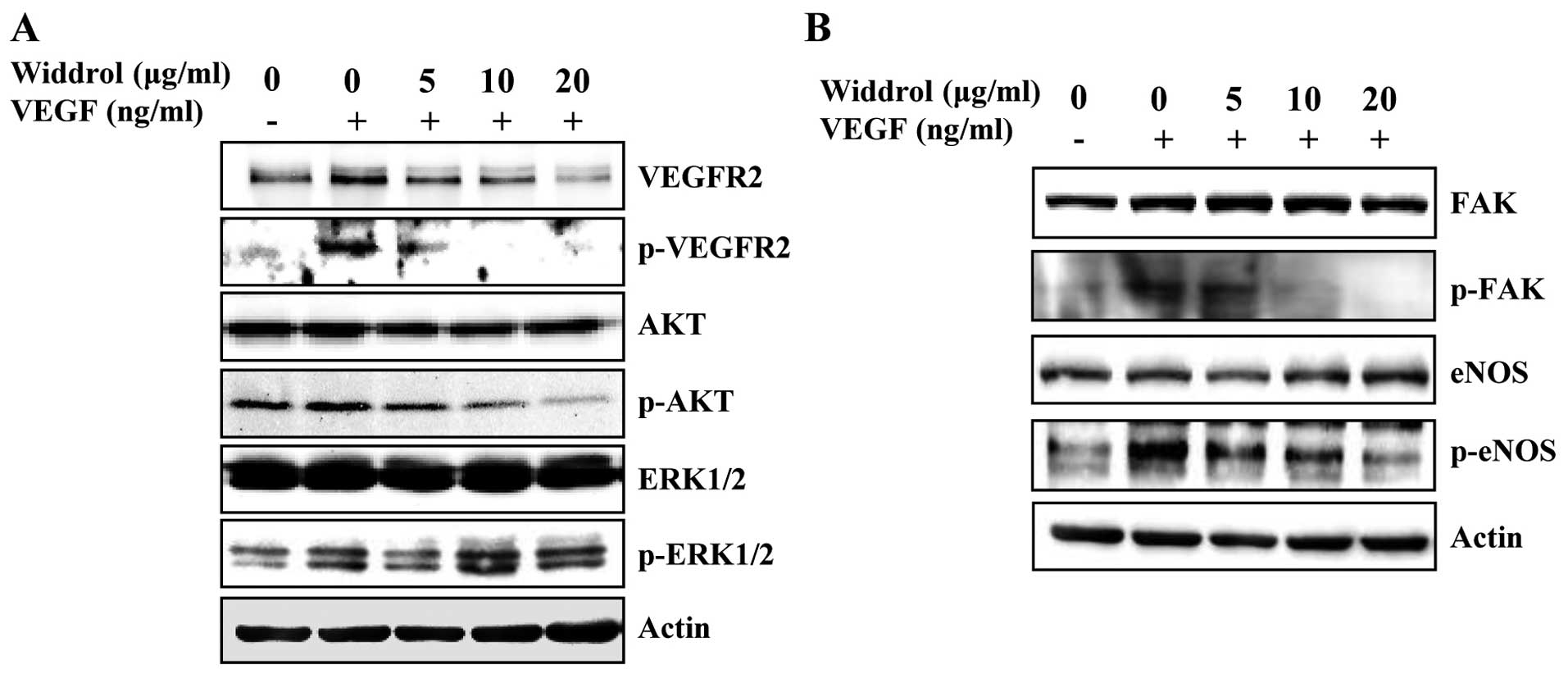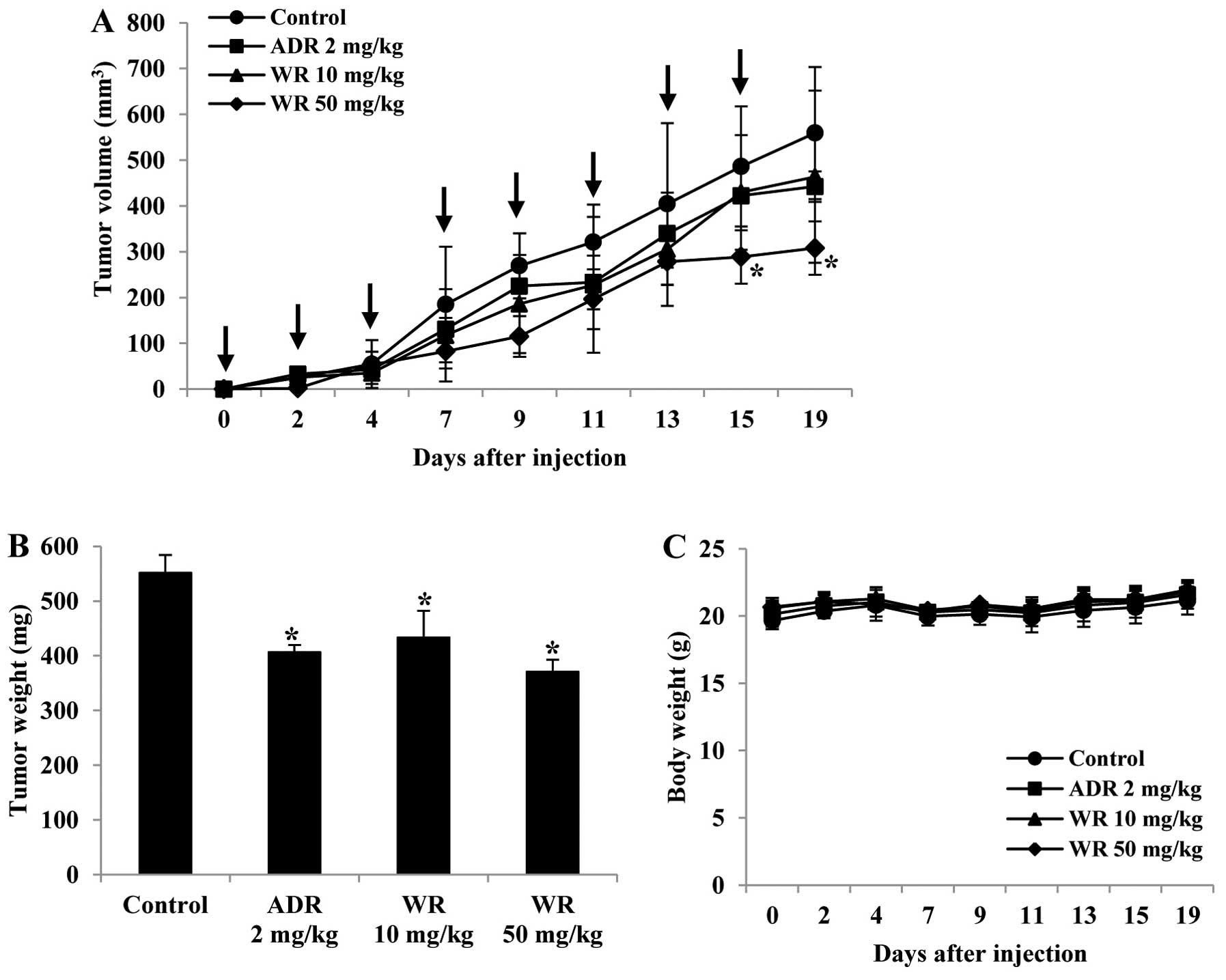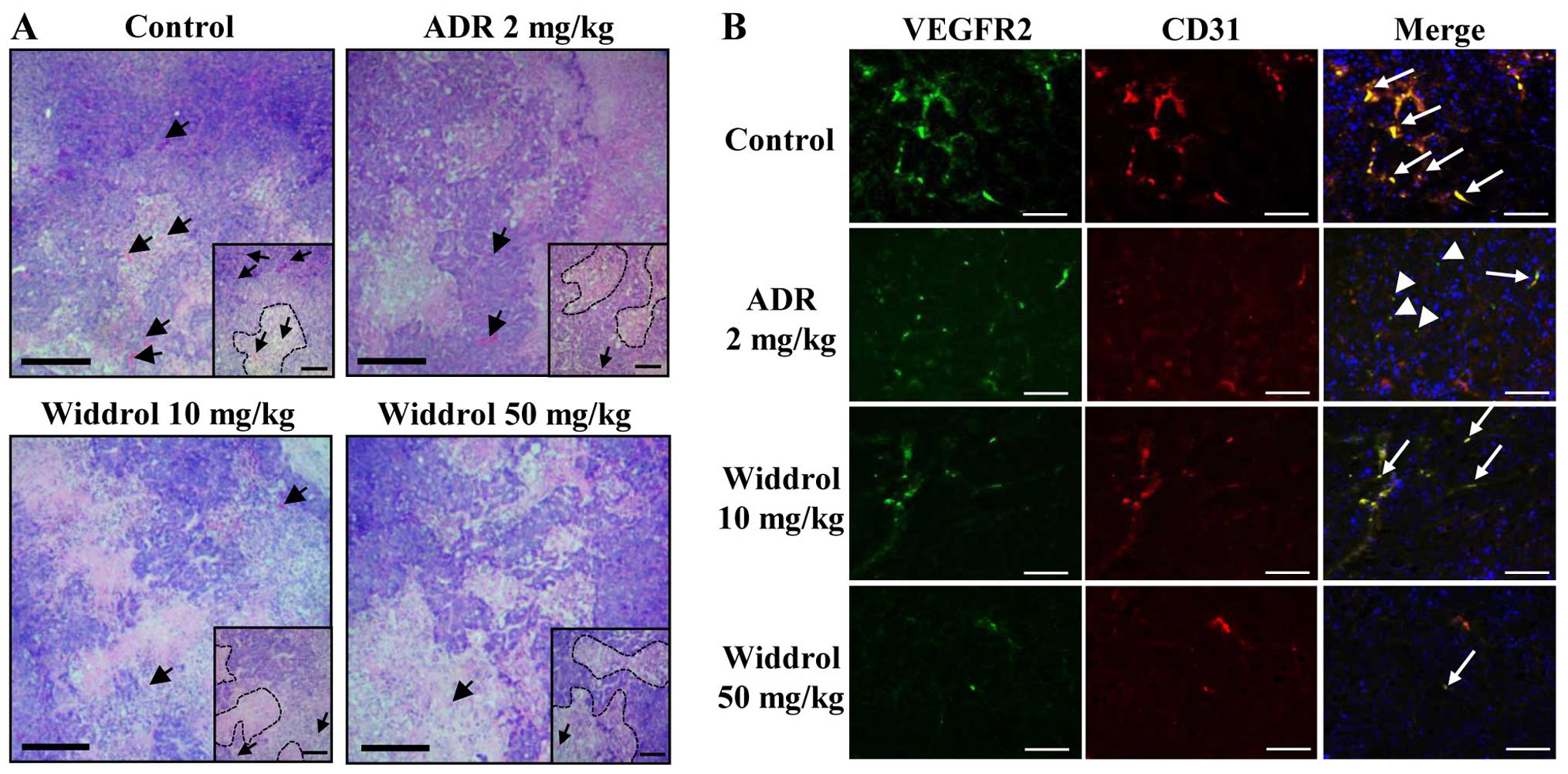Widdrol, a sesquiterpene isolated from Juniperus chinensis, inhibits angiogenesis by targeting vascular endothelial growth factor receptor 2 signaling
- Authors:
- Published online on: June 24, 2015 https://doi.org/10.3892/or.2015.4075
- Pages: 1178-1184
Abstract
Introduction
Tumor angiogenesis, one of the key steps in tumor growth and metastasis, is the process wherein new blood vessels form from the existing vasculature to penetrate into tumors to supply oxygen and essential nutrients (1,2). Tumors induce the growth of new blood vessels by secretion of various growth factors including vascular endothelial growth factor (VEGF), which is a very specific mitogen for vascular endothelial cells (3,4). VEGF expressed by various cancer cells triggers tumor angiogenesis by binding to its receptor, mainly vascular endothelial growth factor receptor 2 (VEGFR2) (5). Stimulation of VEGFR2 results in the activation of several downstream signaling pathways, including the mitogen-associated protein kinase (MAPK)/extracellular signal-regulated kinase (ERK) pathway and the phosphoinositide 3-kinase (PI3K)/AKT/endothelial nitric oxide synthase (eNOS) pathway, to induce endothelial cell proliferation, migration and permeabilization (6,7). Since angiogenesis is one of the critical steps in cancer biology, the inhibition of tumor angiogenesis is a promising approach for cancer chemoprevention and therapy, and the potential of anti-angiogenic drugs to control tumor growth and metastasis is currently under investigation (8).
The proliferation of endothelial cells is an essential step for angiogenesis and is directly induced by progression of the cell cycle (9). The cell cycle can be divided in G0/G1, S, G2 and M phases which are regulated by various checkpoint protein families including cyclins, cyclin-dependent kinases (CDKs) and CDK inhibitors (10). CDK-cyclin complex activation occurs to progress the checkpoint system. Specifically, CDK2/cyclin E and CDK4/cyclin D1 complexes are essential for G1/S transition and are inactivated by CDK inhibitors, such as p21 and p27 (11).
Juniperus chinensis (J. chinensis), a well-known folk remedy in Korea, has been reported to exhibit antitumor, antimicrobial and diuretic properties. Previously, we demonstrated that widdrol, a natural sesquiterpene from J. chinensis, induces cell cycle arrest and apoptosis in human colon adenocarcinoma HT29 cells in vitro (12,13). However, the anti-angiogenic activity of widdrol has yet to be fully determined. In the present study, we investigated the anti-angiogenic efficacy of widdrol and its underlying molecular mechanisms of action using human umbilical vein endothelial cells (HUVECs) and tumor xenograft mice.
Materials and methods
Chemicals
Widdrol was isolated from J. chinensis as previously described (12). Widdrol was dissolved in dimethyl sulfoxide (DMSO) for the in vitro studies and dissolved in a solution containing 10% ethanol and Cremophor EL (both from Sigma-Aldrich, St. Louis, MO, USA) in distilled water for the in vivo experiment.
Animals
Female BALB/c nude mice (BALB/c-nu) were obtained from Japan SLC Inc. (Shizuoka, Japan), and used at 6–8 weeks of age. The animals were housed in microisolator cages under standard conditions for humidity, room temperature and dark-light cycles. The animal experiments were performed in compliance with the Dong-Eui University Animal Care guideline (approval no. R2013-001).
Cell lines and culture
HUVECs purchased from Clonetics (Walkersville, MD, USA) were maintained in EBM-2 medium containing 2% fetal bovine serum (FBS), angiogenic growth factors and 1 µg/ml GA-1000 (gentamicin, amphotericin-B) of EGM-2 BulletKit (Lonza, Walkersville, MD, USA) under standard culture conditions (37°C and 5% CO2). To examine the effect of widdrol on VEGF-related signaling, HUVECs were cultured with EBM-2 medium containing 0.5% FBS and 100 ng/ml of VEGF (Sigma-Aldrich). Human colon adenocarcinoma HT29 cells, were obtained from the American Type Culture Collection (ATCC; Manassas, VA, USA). HT29 cells were cultured in Dulbecco's modified Eagle's medium (DMEM) containing 10% FBS and penicillin/streptomycin under standard culture conditions.
Endothelial cell growth and death assays
Cell viability was assessed using a water-soluble tetrazolium salt (WST) assay using the EZ-Cytox Cell Viability Assay kit (Daeil Lab, Seoul, Korea). EZ-Cytox assay reagent (10 µl) was added to each cell culture well, and the mixture was incubated for 30 min at 37°C. The absorbance was measured at 450 nm using a plate reader (Beckman Coulter, Fullerton, CA, USA). A trypan blue exclusion assay was performed as previously described (12). The cells were treated with widdrol, trypsinized, and stained with trypan blue. Viable cells were counted with a hemocytometer.
Flow cytometric analysis of cell cycle
Cell cycle analysis was performed using a CycleTest DNA reagent kit (Becton-Dickinson, San Jose, CA, USA) according to the manufacturer's instructions. Flow cytometry was conducted (Cell Lab Quanta SC; Beckman Coulter) and the relative DNA content was determined using the FlowJo software (Tree Star, Inc., Ashland, OR, USA).
Western blot analysis
For western blot analysis, 30–50 µg/ml of proteins were resolved by sodium dodecyl sulfate-polyacrylamide gel electrophoresis and blotted onto nitrocellulose membranes. Blots were incubated at 4°C overnight with specific primary antibodies followed by horseradish peroxidase-conjugated secondary antibodies and visualized by an enhanced chemiluminescence detection system (FluorChem®FC2; Alpha Innotech, San Leandro, CA, USA) using Western Blotting Luminol reagent (Santa Cruz Biotechnology, Dallas, TX, USA). CDK2, CDK4, cyclin D1 and E, p53, p27, AKT, ERK1/2, actin primary antibodies and peroxidase-conjugated secondary antibodies were purchased from Santa Cruz Biotechnology. Primary antibodies against p21, p-AKT, p-ERK1/2, VEGFR2, p-VEGFR2, eNOS, p-eNOS, focal adhesion kinase (FAK) and p-FAK were purchased from Cell Signaling Technology (Beverly, CA, USA).
Tube formation assay
The tube formation assay was performed as previously described (14). Briefly, HUVECs were seeded on Matrigel-coated plates (BD Biosciences, San Jose, CA, USA) in EBM-2 medium containing 0.5% FBS, and treated with widdrol. After 6 and 24 h of incubation, the tube formation was observed under a phase contrast microscope. For the quantitative data, tube formation was scored by counting the number of branch points of tubular structure.
Wound-healing assay
The wound-healing assay was performed as previously described (14). The wounded monolayers of HUVECs were recorded by photography and then incubated for 16 h in fresh EBM-2 medium supplemented with 0.5% FBS in the presence of DMSO or various concentrations of widdrol. After incubation, images of cells were captured and the migrated cells were counted from three randomly selected fields. Inhibition percentage was expressed as a percentage relative to the vehicle control (100%).
In vivo tumor xenograft study
HT29 cells (5×106) were implanted subcutaneously into the lateral flanks of female athymic (BALB/c-nu) mice. When the tumor mass was palpable, widdrol (10 and 50 mg/kg) or adriamycin (2 mg/kg; Sigma-Aldrich), as a positive control (15), was administered to the mice (n=5 each group) intravenously three times a week for 15 days. Simultaneously, all the mice were weighed and the tumor volume was measured and calculated using the formula: tumor volume (mm3) = [length × (width)2] × π/6. After 19 days of injection, the mice were sacrificed and the tumors were removed and weighed. Tumor paraffin blocks were sectioned at 5-µm thickness and stained with hematoxylin and eosin (H&E). Histological changes were observed under a light microscope (Eclipse C; Nikon, Tokyo, Japan). For immunofluorescence staining, the slides were incubated with the antibodies against CD31/PECAM1 and VEGFR2, followed by incubation with Alexa-594- and Alexa-488-labeled secondary antibodies, respectively. The nuclei were counterstained with 4′,6-diamidino-2-phenylindole (DAPI; Sigma-Aldrich). Positive signals were photographed under a fluorescence microscope (Axio Scope A; Carl Zeiss, Jena, Germany). The primary antibodies were purchased from Cell Signaling Technology and fluorescent dye-tagged secondary antibodies were from Santa Cruz Biotechnology.
Statistical analysis
The data were presented as the mean ± SD from at least three independent experiments. Statistical comparisons between groups were performed by the SPSS program followed by a Student's t-test. P<0.05 was considered statistically significant.
Results
Widdrol inhibits the VEGF-induced proliferation and cell cycle progression of HUVECs
Since angiogenesis primarily requires the proliferation of endothelial cells initiated by growth factors, we evaluated the inhibitory effect of widdrol on the VEGF-induced proliferation of HUVECs. As shown in Fig. 1A, the proliferation of HUVECs stimulated by VEGF was decreased by widdrol at concentrations >10 µg/ml. The number of viable cells was decreased by widdrol in a dose-dependent manner using the trypan blue exclusion assay (Fig. 1B). To demonstrate the mechanism of inhibition of HUVEC proliferation by widdrol, the effect of widdrol on progression of the cell cycle in HUVECs was subsequently examined. Compared to the untreated control, HUVECs treated with 20 µg/ml of widdrol showed a marked increase in G1 phase from 61.9 to 85.7%, indicating that widdrol induces G1 arrest of HUVECs (Fig. 1C and Table I). Widdrol-mediated G1 arrest was associated with the upregulation of CDK inhibitors, p21 and p27, and the downregulation of G1/S transition-related proteins, CDK2 and cyclin E (Fig. 1D). These results suggested that widdrol inhibited the proliferation of HUVECs by blocking the cell cycle progression associated with the increase of p21 expression and the inactivation of the CDK2/cyclin E complex.
Widdrol inhibits the migration and tube formation of HUVECs in vitro
To investigate the anti-angiogenic activity of widdrol in vitro, we carried out wound-healing and tube formation assays at a non-toxic dose of widdrol. As shown in Fig. 2A, widdrol effectively inhibited the cell migration of HUVECs in a dose-dependent manner. Compared to the control, 10 µg/ml of widdrol treatment for 16 h showed 44% inhibition of cell migration (Fig. 2B). We also found that the tube formation of HUVECs was suppressed by widdrol treatment, while the untreated HUVECs formed robust tube-like structures (Fig. 2C). The quantitative data showed that widdrol inhibited the tube formation of HUVECs in a dose- and time-dependent manner by 35 and 50% inhibition after 6 and 24 h of incubation, respectively (Fig. 2D). These results indicate that widdrol exerts an anti-angiogenic effect by blocking the endothelial cell migration and tube formation in vitro.
Widdrol suppresses the VEGFR2-mediated signaling pathway
To determine the molecular mechanism of widdrol-mediated anti-angiogenesis, the expression and phosphorylation of VEGFR2 and its downstream molecules was examined in HUVECs by western blot analysis. As shown in Fig. 3A and B, the VEGF-stimulated phosphorylation of VEGFR2, AKT and FAK was markedly suppressed by widdrol in a dose-dependent manner. Although it was slightly reduced by 5 µg/ml of widdrol, the phosphorylation of ERK1/2 did not show apparent changes in response to widdrol treatment. Widdrol also inhibited phosphorylation of eNOS, which is downstream of AKT, in a dose-dependent manner. These results collectively suggested that widdrol blocks VEGFR2 signaling via AKT and FAK inactivation, leading to the inhibition of angiogenesis in HUVECs.
Widdrol inhibits tumor growth in vivo
In order to evaluate the effect of widdrol on tumor growth and angiogenesis in vivo, we established the xenograft model using colon adenocarcinoma HT29 cells. As shown in Fig. 4A and B, widdrol significantly reduced tumor volume and weight compared to vehicle control in a dose-dependent manner. Treatment with 50 mg/kg of widdrol inhibited tumor growth more effectively than treatment with adriamycin (2 mg/kg) as a positive control. However, widdrol treatment did not cause body weight loss, suggesting that widdrol has an anticancer efficacy in vivo without any apparent toxicity (Fig. 4C).
Widdrol changes the histological structure and regulates angiogenesis in tumor xenograft mice
To examine whether widdrol inhibits angiogenesis in vivo, the vessel formation in tumor tissue was observed using histochemical studies. After H&E staining, the histological changes in tumor were examined. As shown in Fig. 5A, tumor cells of the control group (with vehicle only) were packed densely in parenchyma (insets) and the blood vessels were easily observed in stroma (arrow). By contrast, tumor cells of the widdrol- or adriamycin-treated group were sparse as compared to those of the control group in parenchyma and the blood vessels were hardly detected in stroma. For immunofluorescence staining, the paraffin blocks of tumor were sectioned and stained with specific antibodies against CD31, a pan-endothelial cell marker, and VEGFR2. As shown in Fig. 5B, CD31 and VEGFR2 expression was distinctly detected in control tumor tissues and the CD31-positive endothelial cells simultaneously expressed VEGFR2 (arrow). Although CD31-positive cells were significantly decreased, VEGFR2 expression in the adriamycin-treated group continued to be observed but was slightly decreased (arrowhead) as compared to the control group. However, in the widdrol-treated group, CD31 and VEGFR2 double-positive cells were decreased in a dose-dependent manner. Compared to the control group, the treatment of 50 mg/kg widdrol induced a marked decrease of CD31 and VEGFR2 expression in tumor tissues. These results indicated that widdrol induces histological changes of tumor and effectively inhibits tumor angiogenesis with the suppression of CD31 and VEGFR2 expression in colon tumor xenograft mice.
Discussion
Angiogenesis is a complex multistep process including endothelial cell proliferation, migration and capillary formation, and plays a critical role in tumor growth and metastasis (16,17). Endothelial cells are activated by various angiogenic stimuli including VEGF, one of the most potent pro-angiogenic factors, to release nitric oxide (NO) and degradative enzymes allowing them to migrate and penetrate into the tumor mass or tissues, resulting in neovascularization (18–20). It has been reported that the signaling events of VEGF mainly occur via VEGFR2 and regulating VEGFR2 activity can modulate angiogenesis, making VEGFR2 an attractive target for antitumor drugs (21–23). It also has been suggested that downstream of VEGFR2, such as ERK, PI3K/AKT and FAK pathway, can be a potential target for therapeutics because it plays a critical role in regulating tumor angiogenesis (24,25). The anticancer efficacy of natural products, such as flavonoids and terpenes, has been examined and it has been demonstrated that various natural compounds can inhibit angiogenesis in vitro and in vivo (26–28). In vitro anticancer activity of widdrol has been reported (12,13), however, the anti-angiogenic activity of widdrol has yet to be fully elucidated.
In the present study, we found that the expression of CDK2 and cyclin E was decreased, whereas the expression of p21 was increased by widdrol in HUVECs, resulting in the inhibition of cell proliferation by cell cycle arrest. Widdrol effectively suppressed the phosphorylation of VEGFR2, AKT and FAK, leading to blocking of cell migration and tube formation of HUVECs. We also found that widdrol inhibited the phosphorylation of eNOS, a downstream molecule of AKT, requiring further studies to ascertain the widdrol-mediated inhibition of endothelial NO production. Widdrol successfully inhibited tumor growth accompanied by a decrease of CD31 and VEGFR2 double-positive endothelial cells, indicating that tumor angiogenesis is suppressed by widdrol. Similar to our finding, Xiao et al showed that phenethyl isothiocyanate, a constituent of cruciferous vegetables, exerted an anti-angiogenic effect in HUVECs associated with the downregulation of VEGFR2 protein levels and inactivation of AKT (29). It has been reported that catunaregin, a marine compound, showed anti-angiogenic effects and significantly decreased the phosphorylation of AKT and eNOS (30).
Moreover, recent findings have revealed that VEGF promotes endothelial cell proliferation via ERK and AKT pathways and is associated with the increase of cyclin A, D1 and E expression as well as the decrease of CDK inhibitor expression (31,32). Based on these studies, our data suggest that the inhibition of VEGFR2 signaling via the AKT pathway using widdrol leads to inactivation of the CDK/cyclin complex and induction of CDK inhibitor expression, followed by cell cycle arrest and proliferation inhibition.
In summary, to the best of our knowledge, our observations firstly reveal the anti-angiogenic efficacy of widdrol and suggest the mechanisms of widdrol-mediated anti-angiogenesis. Widdrol suppressed endothelial cell proliferation by cell cycle arrest and inhibited angiogenesis by targeting VEGFR2 signaling by blocking AKT and FAK activation. In tumor xenograft mice, the reduction of tumor growth and a decrease of vascular structure were observed by widdrol treatment. Therefore, our findings suggest that widdrol possesses potential antitumor activities by inhibiting tumor angiogenesis, suggesting that widdrol may act as an anti-angiogenic agent and may contribute to anticancer drug development.
Acknowledgments
This study was supported by the Basic Science Research Program through the National Research Foundation of Korea (NRF) funded by the Ministry of Science, ICT and Future Planning (2012R1A1A3011936).
References
|
Folkman J: Tumor angiogenesis: Therapeutic implications. N Engl J Med. 285:1182–1186. 1971. View Article : Google Scholar : PubMed/NCBI | |
|
Kerbel RS: Tumor angiogenesis: Past, present and the near future. Carcinogenesis. 21:505–515. 2000. View Article : Google Scholar : PubMed/NCBI | |
|
Alon T, Hemo I, Itin A, Pe'er J, Stone J and Keshet E: Vascular endothelial growth factor acts as a survival factor for newly formed retinal vessels and has implications for retinopathy of prematurity. Nat Med. 1:1024–1028. 1995. View Article : Google Scholar : PubMed/NCBI | |
|
Ferrara N: Vascular endothelial growth factor: Molecular and biological aspects. Curr Top Microbiol Immunol. 237:1–30. 1999.PubMed/NCBI | |
|
Dvorak HF, Brown LF, Detmar M and Dvorak AM: Vascular permeability factor/vascular endothelial growth factor, microvascular hyperpermeability, and angiogenesis. Am J Pathol. 146:1029–1039. 1995.PubMed/NCBI | |
|
Dimmeler S, Fleming I, Fisslthaler B, Hermann C, Busse R and Zeiher AM: Activation of nitric oxide synthase in endothelial cells by Akt-dependent phosphorylation. Nature. 399:601–605. 1999. View Article : Google Scholar : PubMed/NCBI | |
|
Olsson AK, Dimberg A, Kreuger J and Claesson-Welsh L: VEGF receptor signalling - in control of vascular function. Nat Rev Mol Cell Biol. 7:359–371. 2006. View Article : Google Scholar : PubMed/NCBI | |
|
Ferrara N and Kerbel RS: Angiogenesis as a therapeutic target. Nature. 438:967–974. 2005. View Article : Google Scholar : PubMed/NCBI | |
|
Zheng X, Li A, Zhao L, Zhou T, Shen Q, Cui Q and Qin X: Key role of microRNA-15a in the KLF4 suppressions of proliferation and angiogenesis in endothelial and vascular smooth muscle cells. Biochem Biophys Res Commun. 437:625–631. 2013. View Article : Google Scholar : PubMed/NCBI | |
|
Roberts JM, Koff A, Polyak K, Firpo E, Collins S, Ohtsubo M and Massagué J: Cyclins, Cdks, and cyclin kinase inhibitors. Cold Spring Harb Symp Quant Biol. 59:31–38. 1994. View Article : Google Scholar : PubMed/NCBI | |
|
Sherr CJ and Roberts JM: CDK inhibitors: Positive and negative regulators of G1-phase progression. Genes Dev. 13:1501–1512. 1999. View Article : Google Scholar : PubMed/NCBI | |
|
Kwon HJ, Hong YK, Park C, Choi YH, Yun HJ, Lee EW and Kim BW: Widdrol induces cell cycle arrest, associated with MCM down-regulation, in human colon adenocarcinoma cells. Cancer Lett. 290:96–103. 2010. View Article : Google Scholar | |
|
Kwon HJ, Lee EW, Hong YK, Yun HJ and Kim BW: Widdrol from Juniperus chinensis induces apoptosis in human colon adenocarcinoma HT29 cells. Biotechnol Bioprocess Eng. 15:167–172. 2010. View Article : Google Scholar | |
|
Martínez-Poveda B, Muñoz-Chápuli R, Rodríguez-Nieto S, Quintela JM, Fernández A, Medina MA and Quesada AR: IB05204, a dichloropyridodithienotriazine, inhibits angiogenesis in vitro and in vivo. Mol Cancer Ther. 6:2675–2685. 2007. View Article : Google Scholar : PubMed/NCBI | |
|
Argov M, Kashi R, Peer D and Margalit R: Treatment of resistant human colon cancer xenografts by a fluoxetine-doxorubicin combination enhances therapeutic responses comparable to an aggressive bevacizumab regimen. Cancer Lett. 274:118–125. 2009. View Article : Google Scholar | |
|
Folkman J: Role of angiogenesis in tumor growth and metastasis. Semin Oncol. 29(Suppl 16): 15–18. 2002. View Article : Google Scholar | |
|
He D, Jin J, Zheng Y, Bruce IC, Tam S and Ma X: Anti-angiogenesis effect of trichosanthin and the underlying mechanism. Biochem Biophys Res Commun. 430:735–740. 2013. View Article : Google Scholar | |
|
Rössler J, Taylor M, Geoerger B, Farace F, Lagodny J, Peschka-Süss R, Niemeyer CM and Vassal G: Angiogenesis as a target in neuroblastoma. Eur J Cancer. 44:1645–1656. 2008. View Article : Google Scholar : PubMed/NCBI | |
|
Shizukuda Y, Tang S, Yokota R and Ware JA: Vascular endothelial growth factor-induced endothelial cell migration and proliferation depend on a nitric oxide-mediated decrease in protein kinase Cdelta activity. Circ Res. 85:247–256. 1999. View Article : Google Scholar : PubMed/NCBI | |
|
Taimeh Z, Loughran J, Birks EJ and Bolli R: Vascular endothelial growth factor in heart failure. Nat Rev Cardiol. 10:519–530. 2013. View Article : Google Scholar : PubMed/NCBI | |
|
Eskens FA and Verweij J: The clinical toxicity profile of vascular endothelial growth factor (VEGF) and vascular endothelial growth factor receptor (VEGFR) targeting angiogenesis inhibitors; a review. Eur J Cancer. 42:3127–3139. 2006. View Article : Google Scholar : PubMed/NCBI | |
|
Saraswati S, Kanaujia PK, Kumar S, Kumar R and Alhaider AA: Tylophorine, a phenanthraindolizidine alkaloid isolated from Tylophora indica exerts antiangiogenic and antitumor activity by targeting vascular endothelial growth factor receptor 2-mediated angiogenesis. Mol Cancer. 12:822013. View Article : Google Scholar : PubMed/NCBI | |
|
Takahashi S: Vascular endothelial growth factor (VEGF), VEGF receptors and their inhibitors for antiangiogenic tumor therapy. Biol Pharm Bull. 34:1785–1788. 2011. View Article : Google Scholar : PubMed/NCBI | |
|
Cheng JQ, Lindsley CW, Cheng GZ, Yang H and Nicosia SV: The Akt/PKB pathway: Molecular target for cancer drug discovery. Oncogene. 24:7482–7492. 2005. View Article : Google Scholar : PubMed/NCBI | |
|
Jiang BH and Liu LZ: AKT signaling in regulating angiogenesis. Curr Cancer Drug Targets. 8:19–26. 2008. View Article : Google Scholar : PubMed/NCBI | |
|
Yue GG, Chan BC, Kwok HF, Wong YL, Leung HW, Ji CJ, Fung KP, Leung PC, Tan NH and Lau CB: Anti-angiogenesis and immunomodulatory activities of an anti-tumor sesquiterpene bigelovin isolated from Inula helianthus-aquatica. Eur J Med Chem. 59:243–252. 2013. View Article : Google Scholar | |
|
Hong SW, Jung KH, Lee HS, Son MK, Yan HH, Kang NS, Lee J and Hong SS: SB365, Pulsatilla saponin D, targets c-Met and exerts antiangiogenic and antitumor activities. Carcinogenesis. 34:2156–2169. 2013. View Article : Google Scholar : PubMed/NCBI | |
|
Wang Y, Ma W and Zheng W: Deguelin, a novel anti-tumorigenic agent targeting apoptosis, cell cycle arrest and anti-angiogenesis for cancer chemoprevention. Mol Clin Oncol. 1:215–219. 2013. | |
|
Xiao D and Singh SV: Phenethyl isothiocyanate inhibits angiogenesis in vitro and ex vivo. Cancer Res. 67:2239–2246. 2007. View Article : Google Scholar : PubMed/NCBI | |
|
Liu JX, Luo MQ, Xia M, Wu Q, Long SM, Hu Y, Gao GC, Yao XL, He M, Su H, et al: Marine compound catunaregin inhibits angiogenesis through the modulation of phosphorylation of akt and eNOS in vivo and in vitro. Mar Drugs. 12:2790–2801. 2014. View Article : Google Scholar : PubMed/NCBI | |
|
Favot L, Keravis T and Lugnier C: Modulation of VEGF-induced endothelial cell cycle protein expression through cyclic AMP hydrolysis by PDE2 and PDE4. Thromb Haemost. 92:634–645. 2004.PubMed/NCBI | |
|
Shi F, Wang YC, Zhao TZ, Zhang S, Du TY, Yang CB, Li YH and Sun XQ: Effects of simulated microgravity on human umbilical vein endothelial cell angiogenesis and role of the PI3K-Akt-eNOS signal pathway. PLoS One. 7:e403652012. View Article : Google Scholar : PubMed/NCBI |



